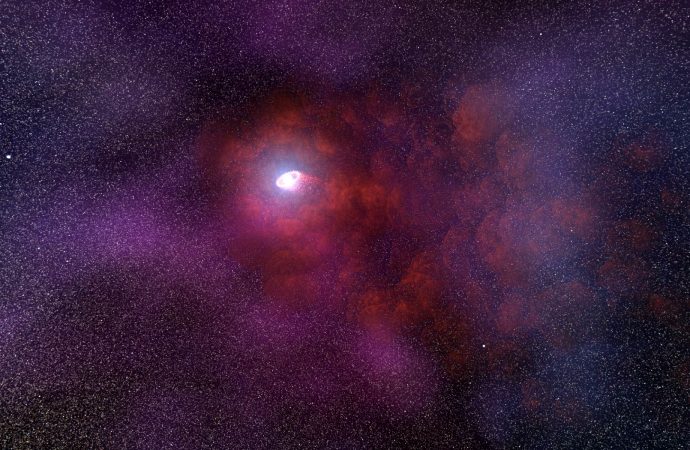An unusual infrared emission from the neutron star RX J0806.4-4123 detected by the NASA/ESA Hubble Space Telescope could indicate new features never before seen: one possibility is that there is a disk of material surrounding the neutron star; another is that there is an energetic wind coming off RX J0806.4-4123 and slamming into gas in interstellar space the neutron star is plowing through.
“RX J0806.4-4123 belongs to a group of seven nearby X-ray pulsars (the Magnificent Seven) that are hotter than they ought to be considering their ages and available energy reservoir provided by the loss of rotation energy,” said Dr. Bettina Posselt, a researcher in the Department of Astronomy & Astrophysics at Pennsylvania State University.
“We observed an extended area of infrared emissions around RX J0806.4-4123, the total size of which translates into about 200 AU (astronomical units) at the assumed distance of the pulsar.”
This is the first neutron star in which an extended emission has been seen only in the infrared.
Dr. Posselt and colleagues suggest two possibilities that could explain this extended infrared emission.
The first is that there is a disk of material (possibly mostly dust) surrounding RX J0806.4-4123. The second is a so-called ‘pulsar wind nebula.’

This animation depicts RX J0806.4-4123 with a disk of warm dust that produces an infrared signature as detected by the NASA/ESA Hubble Space Telescope. The disk wasn’t directly photographed, but one way to explain the data is by hypothesizing a disk structure that could be 18 billion miles across. The disk would be made up of material falling back onto the neutron star after the supernova explosion that created the stellar remnant. Image credit: NASA / ESA / Nahks Tr’Ehnl, Pennsylvania State University.
“One theory is that there could be what is known as a ‘fallback disk’ of material that coalesced around the neutron star after the supernova,” Dr. Posselt said.
“Such a disk would be composed of matter from the progenitor massive star. Its subsequent interaction with the neutron star could have heated the pulsar and slowed its rotation.”
“If confirmed as a supernova fallback disk, this result could change our general understanding of neutron star evolution.”
“A pulsar wind nebula would require that the neutron star exhibits a pulsar wind,” she added.
“A pulsar wind can be produced when particles are accelerated in the electric field that is produced by the fast rotation of a neutron star with a strong magnetic field. As the neutron star travels through the interstellar medium at greater than the speed of sound, a shock can form where the interstellar medium and the pulsar wind interact. The shocked particles would then radiate synchrotron emission, causing the extended infrared emission that we see.”
“Typically, pulsar wind nebulae are seen in X-rays and an infrared-only pulsar wind nebula would be very unusual and exciting.”
The findings appear in the Astrophysical Journal.
Source: Sci News

































Leave a Comment
You must be logged in to post a comment.